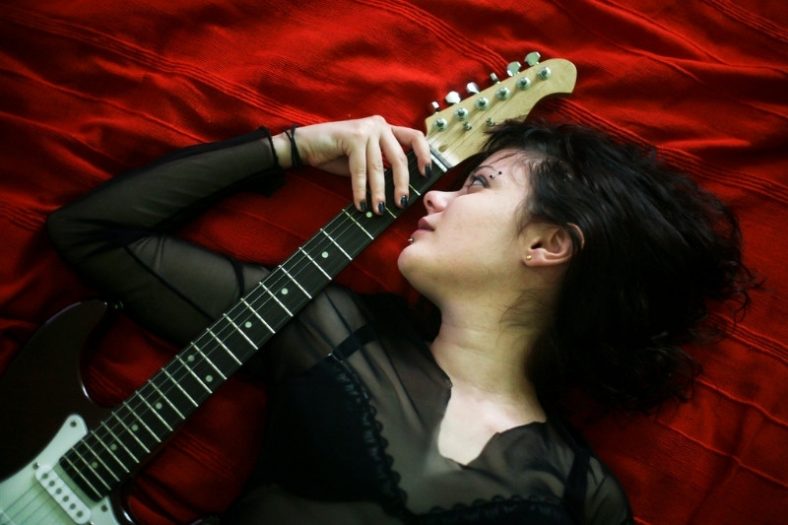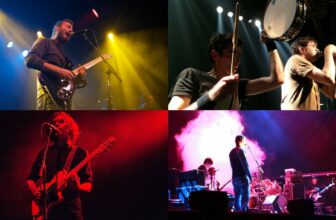What is Goth Music? (Gothic Rock)

Goth music or Gothic rock is a style of rock music that emerged in the late 70s and went on to inspire the Goth subculture of the next three decades. This genre is known for its dark soundscapes and largely grim, or mystical, lyrical themes.
Contents
History and Origin
By the mid-60s, ‘Rock and Roll’ had started developing into a wide range of different styles. Changing political and social climates – along with advancements in technology – influenced sounds, lyrical themes, and subsequently diverse subgenres of rock music.
These developments took place largely in the US and the UK, with artists and bands continually pushing boundaries, determined to abandon existing tropes and cliches. In the late 70s, post-punk artists broke off from punk rock, feeling it had fallen into a simplistic and commercial formula.
They experimented with styles like funk, jazz, and electronic music, and diverse themes appropriated from art, literature, philosophy, and politics. Eventually, some bands from the UK, like Siouxsie and the Banshees and The Cure, started shifting to dark music with gothic overtones and thus pioneered the genre of Gothic rock.
Some acts, like The Doors and Alice Cooper, had been incorporating dark elements into their music and performances since the late 60s. The distinct, eerie sounds and somber lyrics of Nico’s 1968 album The Marble Index became an important influence for Gothic rock. The genre was also influenced by the Velvet Underground’s use of drones, which were employed to create dark atmospheres.
These artists could be considered the forerunners of Gothic rock. However, Goth music as we know it emerged only in the very late 70s and early 80s.
Bauhaus’s debut single ‘Bela Lugosi’s dead’ in 1979 is now considered to be the beginning of the genre. Bauhaus has cited Siouxsie and the Banshees to be one of their main influences, although the latter started including gothic characteristics in their music only from their 1981 album Juju.
The Cure also shifted to darker music with their 1980 album Seventeen Seconds. Their performances and release of subsequent albums cemented their place as one of the pioneers of Gothic rock. They went on to become the most commercially successful of these groups.
Meanwhile, the american bands 45 grave and Christian Death are considered to have started Gothic rock in the USA in the early 80s.
Gothic Inspirations
The term ‘Gothic’ comes from the Gothic literature of the 19th century. Consider the story about Frankenstein or Dracula. Gothic rock was inspired by the themes of horror, morbidity, death, and the supernatural prevalent in Gothic fiction.
Goth music deals with tragedy, melancholy, morbidity, existentialism, nihilism, and the romantic idealization of death.
Musicians of this genre generally tried to bring elements of horror and the supernatural into their performances. Their fashions often included Victorian, Renaissance, and medieval-style attire – again inspired by the settings of Gothic fiction, as well as punk and androgynous outfits. Black hair, clothing, and dark make-up were popular.
Performances and music videos were usually theatrical and gave importance to showmanship and visual style.
What Does Gothic Rock Sound Like?
To achieve a dark ambiance, Gothic rock incorporates good amounts of reverb, dark arrangements, and dramatic or melancholic melodies. The use of droning sustained notes, or drones, throughout the track is common.
Compositions use primarily minor, bass chords. A bass chord involves playing several low-pitched notes at the same time, thus contributing to a dark, muddy sound. Goth music is characterized by scything guitar riffs, and fast arpeggiations to create atmosphere.
The vocals are often deep and droning, although high-pitched and whispery or screechy vocals are also common. The percussion and beats are either hypnotically slow and solemn or tribal-like with generous use of tom drums.
Popular Gothic Albums
The 80s saw a vast number of Gothic bands and artists like Siouxsie and the Banshees, The Cure, Joy Division, Southern Death Cult, and Sex Gang Children. Even Icelandic group Kukl, which is most notable for being one of Bjorke’s first bands, emerged during this period.
If you’re new to Goth music, here are some classic albums that will give you an authentic feel of what Gothic rock is all about.
Faith, by The Cure
Released in 1981, the album was well-received by critics and received commercial success in the UK.
The entire album has melancholic lyrics and arrangements, with draggy vocals drenched in reverb. The instrumentation is dark, with twangy guitar arpeggios and hypnotic rhythm loops.
One of the gloomiest songs on the album, The Drowning Man, is based on the novel Gormenghast by Mervyn Peake. The lyrics talk about the protagonist Fuchsia drowning in a flood.
The cover art – a picture of the church Bolton Priory in the fog – contributes to the gloomy, horror-like tone of the album.
Juju, by Siouxsie and the Banshees
Released in 1981, Juju was the band’s fourth studio album, but their first one to incorporate Gothic characteristics.
Most of the album is fast-paced, with eerie melodies and lots of distortion on the guitars. Loud kicks and tom drums are used extensively, and the wailing vocals often tilt towards being mildly screechy.
The first track on the album, Spellbound, talks about being haunted or in a ghostly trance. One of the most bone-chilling songs on the album.
In the Flat Field, by Bauhaus
Bauhaus’s debut album, In The Flat Field, released in November 1980, is considered by many to be one of the first Gothic rock records.
The album is characterized by twangy, harsh guitars with large amounts of distortion and fast-paced hypnotic rhythms. Almost all of the tracks have creepily hair-raising sounds thrown into the mix. The creative and unpredictable use of bells, whistles, rattles, beeps, and creaks ups the horror element of the album immensely.
The vocals are largely droning and either monotone or restricted within narrow melodic ranges.
The album received mixed reviews at the time – positive reviews from fanzines and largely negative reviews from music critics. However, in retrospect, the album has been praised for being courageous and pushing the boundaries of rock music.
Goth Music Today
Although the 80s were the peak period for Goth music, the subculture and genre reemerged during the 1990s, and many 2000s bands were seen to have Goth influences.
Today, the genre has largely disappeared from mainstream music, but some niche bands like the Kentucky Vampires are continuing to contribute to Goth music.
Summary
Goth music gave rise to the broad and well-known goth subculture, which included clubs, fashion, and publications.
It could be said that Goth music played a crucial role in encouraging individuals – especially adolescents – to embrace and express their individualities. In a society that obsessively expected people to pleasantly conform, and put on a happy facade, goth music’s melancholic themes perhaps gave teenagers and adults a necessary outlet.
Gothic rock allowed them to escape into worlds that were far removed from reality while giving them a safe haven where they were allowed to be gloomy, passionate, and unorthodox.
Although the popularity of the genre has died down significantly, its wide impacts and influences on even today’s music and culture are undeniable.





